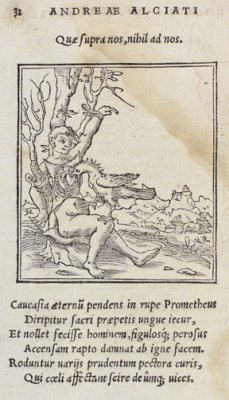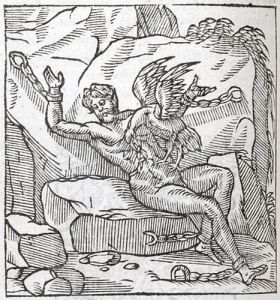In the last issue, I wrote about the relationship between the narratives and the illustrations in the early printed editions of Aesop’s fables. In this article, I discuss a different type of mythological image: the emblem. The emblem genre was enormously popular throughout Europe during the sixteenth and seventeenth centuries. Although the exact layout varied from book to book, each emblematic image was paired with a motto and a textual commentary, often in verse. To show how image and text were combined in this way, I will look at the emblem of Prometheus in the Emblematum liber (Book of Emblems) by the Italian scholar Andrea Alciato.
Alciato’s Emblematum liber was the single most influential of the emblem books. First published in 1531, Alciato’s book gave rise to hundreds of imitations throughout continental Europe. As a general rule, the text remained stable while the images themselves were often significantly different from edition to edition. Alciato himself was not happy with the woodcut illustrations in the 1531 edition, nor with what he considered to be the careless layout of the pages, where sometimes the motto and the image appeared on separate pages as you can see here in the Prometheus emblem:
 Emblematum liber (1531). View larger image »
Emblematum liber (1531). View larger image »
The motto (on the lower left-hand page) reads Quae supra nos, nihil ad nos, “What (is) above us (is) nothing to us,” a saying attributed to Socrates. The motto is a warning that we should have nothing to do with things that are above and beyond us. Accordingly, the image shows Prometheus’s punishment, as a bird eats away at his liver.
Below the image is the verse commentary in elegiac couplets. Here is a literal English translation:
Prometheus hangs for all eternity on a rock in the Caucasus; his liver is shredded by the talon of the sacred winged one. He might rather not have created man — and, detesting the potters, he curses the torch lit from the stolen fire. The breasts of wise men are gnawed by diverse cares — those wise men who feign to know the ways of heaven and of the gods.
The text thus explains, albeit briefly, the events of the mythical story: how Prometheus created man (but now regrets it), and how he shaped the first men from clay (but now he hates the potters and their art), and how he now curses the fire which he stole from heaven to give life to his earthly creation. In some versions of the story Prometheus is viewed as a rebel (see Randy’s discussion of the myth to illustrate two themes concerning man’s relationship to the divine), but in this version, Prometheus is instead a bitter failure. The commentary explains that Prometheus thus symbolizes would-be wise men who seek to know the ways of the gods, and who end up feeling only an endless inner anguish as a result.
In 1534, a new edition of the book was published in France, with woodcuts by Mercure Jollat. In this edition, the presentation is much more systematic, with each emblem (motto and image and commentary) starting on its own page:
 Emblematum Libellus (1534). View larger image »
Emblematum Libellus (1534). View larger image »
The text is unchanged but the image is quite different, and much more detailed, than in the 1531 edition. There are four flaps of skin carefully peeled back to reveal the viscera on which the bird is gnawing, and Prometheus is now shown tied to a tree — a detail that is not part of the traditional myth, and which is not explained in the text.
Was the artist adapting the message of the suffering Prometheus to the symbolic “tree” on which the body of Jesus was crucified and pierced? Are there mystical echoes here of the iconography of the sacred heart of Jesus? Images, like texts, can be allusive, and the meaning of a visual emblem can certainly go beyond the accompanying text, resonating instead with a larger visual code.
In later editions, the tree is replaced by a rocky promontory, more closely aligning the image and the traditional myth as recounted in the text. For example, in this French edition from 1584, you can see the rocky setting of the Caucasus mountains along with the chains which bind Prometheus in place:
 Emblemata (1584). View larger image »
Emblemata (1584). View larger image »
It is this image which finds its way into the first emblem book in the English language: Geffrey Whitney’s A choice of emblemes, published in 1586. Whitney created his book by borrowing from a variety of sources, including approximately 80 emblems from Alciato.
 Geffrey Whitney: A choice of emblemes (1586). View larger image »
Geffrey Whitney: A choice of emblemes (1586). View larger image »
While Whitney borrows the image from Alciato, he uses a new motto and a new verse commentary. The new motto is adapted from the ancient Roman writer Publilius Syrus and reads: O vita, misero longa, “O life, which is long for the person who is wretched.” This new motto makes no mention of the specific reason why Prometheus is being punished, and the same is true of the commentary, where Whitney has shifted the focus exclusively to suffering, without any details of the myth. Here is Whitney’s poem, with modernized spelling:
To Caucasus, behold PROMETHEUS chained, Whose liver still a greedy vulture does rend: He never dies, and yet is always pained With tortures dire, by which the Poets meant, That he, who still amid misfortunes stands, Is sorrow’s slave, and bound in lasting bands. For when that grief does grate upon our gall Or surging seas of sorrows most do swell, That life is death, and is no life at all; The liver, rent, does the conscience tell, Which being lanced and pricked with inward care, Although we live, yet still we dying are.
For Whitney, Prometheus is now a symbol of someone who is dying eternally, in a life made endless by perpetual suffering. Whitney’s Prometheus is not a divine rebel, nor even an emblem of the wise man’s curious and inquiring mind. Instead, Prometheus is simply “sorrow’s slave,” a character whose story consists entirely of “tortures dire,” but without explanation of these “misfortunes.” In Alciato’s emblem book, Prometheus was so consumed by his punishment that he regretted his earlier rebellion but now, in Whitney, there is not even a rebellion left for Prometheus to regret. This Prometheus anticipates a kind of existential angst, a cousin to the Sisyphus later made emblematic by Camus: we feel the torments of Prometheus with every care that gnaws our guts, not even knowing for what crime we have been punished, or what we stood to gain before we were condemned to this life that “is death, and is no life at all.”
Even without the emblem books, of course, we would know that the Prometheus myth has had many different meanings for its many different audiences over the past several thousand years. What is special about the emblem books, however, is the way that they combine both image and text in tandem to tell the story. There were works of art from the ancient world that depicted Prometheus in images, and there were also stories told about him recorded in words (see Theoi.com for an extensive survey). The emblem books of the Renaissance, made possible by the technology of printing, offered something new — the chance to combine text and image into a single multimedia experience, telling a story in words and “beyond words” at one and the same time.
Online Resources
If you are intrigued by the way the emblems work, both illustrating and symbolizing the ancient myths, you can find some wonderful resources online to explore them in detail:
- You can browse through Whitney at the English Emblem Book Project: http://emblem.libraries.psu.edu/whitntoc.htm
- You can browse 22 editions of Alciato at the Glasgow University Emblem web site: http://www.emblems.arts.gla.ac.uk/alciato/index.php
- And for a change of pace, you can browse 27 Dutch love emblem books at the Emblem Project Utrecht: http://emblems.let.uu.nl/


